Chinese carnation: description, planting and care

Chinese carnation is a popular garden plant grown as an annual in the climate of central Russia. In China, this species of the Clove family is grown as a perennial form, found in the wild in China, Korea, Mongolia. The discreet beauty of the Chinese carnation is revealed gradually due to the unusual combination of colors in the color of the petals. In addition, this plant is unpretentious, widely used in landscape design and is able to withstand cultivation in various climatic zones. Many people are interested in how to plant the seeds of Chinese carnation, what rules should be followed when forcing seedlings, how flowers are grown in the open field, where it is better to plant them, which varieties are best suited for the Russian climate. So that planting and caring for a perennial herb does not turn into a difficult puzzle, it is worthwhile to study in more detail all the necessary information about the Chinese carnation.

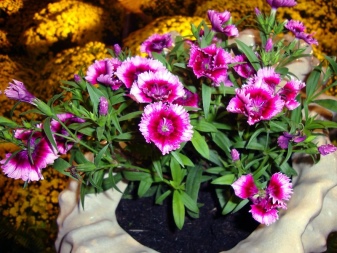
Peculiarities
Dianthus chinensis or Chinese carnation is a perennial herb that is widespread in Asia. It has been used in cultural breeding since 1702, thanks to which the variety of varieties and hybrids can amaze even an experienced gardener. Modern breeding trends are mainly aimed at obtaining more compact bushes, improving the duration of flowering, expanding the color range. In Russia, this species is grown as an annual or a plant with a two-year growing cycle.
What does a Chinese carnation look like? The description of the plant allows you to get a fairly complete picture of its features. Chinese carnation is characterized by the presence of undeveloped roots - they begin to grow and deepen from the second year. When grown in the form of an annual, it will be simply impossible to achieve a different result.
The plant looks like a compact bush with straight stems, consisting of separate sections held together by nodules.
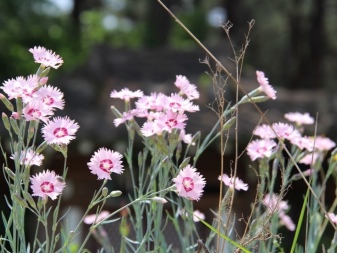

The height of the Chinese carnation reaches 10-50 cm, depending on the variety and type. Flowers look especially attractive, on the petals of which this species has characteristic, recognizable stripes of burgundy color. Carnations have refined, narrow leaves, pointed at the ends. In some varieties, they curl at the ends.
By the type of inflorescence, Chinese carnations are divided into the following:
- simple - with a five-lobed rim and a serrated edge;
- terry - consist of multiple connections of petals;
- semi-double.
The color of the species is diverse, largely due to painstaking breeding work. White, pink, blue, lilac, lilac, red monochromatic varieties are complemented by two-color ones, in which the middle or edge of the petal is contrasting. The calyx diameter ranges from 1 to 4 cm. The seed material has an elongated shape, a fragile shell that can be easily damaged if handled carelessly.



Varieties
The varied varieties of Chinese carnation do best in warm climates, where they can be grown as perennials. In the conditions of central Russia, both hybrids and varietal plants are grown as annuals with an annual planting of new seed material. Let's take a closer look at the most popular varieties.
- Diana Blueberry. A variety of a popular hybrid with an unusual color. A simple five-petal flower cup is colored dark purple. The plant reaches a height of 25 cm, is sun-loving, tolerates a short-term drop in temperature well. The hybrid blooms throughout the warm season, without interruption, and is very decorative.


- "Minstrel". A very spectacular terry variety, reaching a height of 45 cm. The rare black and white color of the petals with a characteristic serrated edge and border makes the plant popular among flower growers. The annual looks good in borders, flower beds, alpine hills, suitable for cutting into bouquets.


- "Vorozheya". An excellent variety of Chinese carnation, especially impressive looking thanks to the original two-tone color of the petals. The dark crimson background is framed by a thin white border, the flower cup is semi-double.
The variety forms abundantly flowers on erect shoots up to 40 cm high, unpretentious in maintenance, suitable for flower beds.
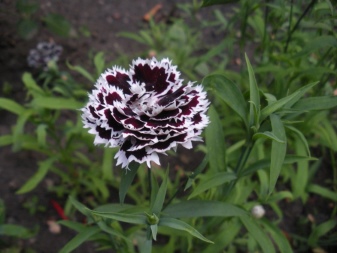

- Terry mix. A very showy variety, a white, scarlet, purple or burgundy carnation with a double structure of petals with pronounced jagged edges. The plant is characterized by an almost complete absence of a characteristic odor, prolonged flowering from June to the end of August. The diameter of the flowers is small - 1–4 cm; there are several buds on the stem. This carnation is well suited for potted cultivation on a windowsill or as a decoration for a curb or rabat.


- "Diana F1 Crimson". A hybrid in white, crimson, scarlet, caramel pink, purple tones. It belongs to the group of Dutch breeding plants, does not differ in tallness - the height of the stems is only 20-25 cm. It is used for growing in containers, border plantings, in flower beds it stands out for the large size of flowers, their diameter reaches 5-7 cm, and long flowering with July to October.


- Grace F1 crimson. Dutch breeding hybrid with double flowers of bright red color, with a white border and stamens. The plant reaches a height of 25 cm, suitable for pot cultivation, planting on the balcony. The diameter of the flower calyx is quite large - it reaches 8 cm.


- "Carousel". This variety of Chinese carnation is dwarf, with compact angular stems and unusually colored flower petals. They are white with a contrasting scarlet middle. The calyx reaches 6 cm in diameter. The edges of the flower are serrated, simple. Such a plant is best considered as a potted plant, due to its small size it is not very well suited for outdoor planting.


Growing seedlings
It is customary to plant Chinese carnations at home when you need to prepare seedlings in advance. Experienced agricultural technicians recommend sowing seeds from January if early spring is observed in the region. In the middle lane for planting, it is better to choose the end of February. Any wide container will do for sowing.
The preparation of the container and the planting of seeds takes place in the following order:
- laying on the bottom of the drainage layer, excluding stagnant water;
- filling with a substrate - a ready-made mixture for seedlings or a composition based on garden soil, sand and vermiculite is suitable;
- distribution of seeds - they need to be evenly scattered over the surface of the soil without deepening, sprinkled on top with vermiculite, which promotes germination;
- moistening the soil - it is better to spray it from a spray bottle with water at room temperature.


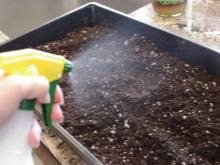
Upon completion of planting, a box or container is placed on the windowsill, it is advisable to choose windows on the south side or provide additional lighting and heating.
The optimal temperature regime for this period should be +20 degrees, it is important to maintain good humidity, but without overflow. After the sprouts appear, it is worth moving the seedlings to a cooler place, maintaining the ambient temperature in the range of + 15– + 17 degrees Celsiusto avoid excessive stretching of the sprouts.


Plants are transplanted into separate containers after 2 leaves appear. In these containers, they are cultivated until they are planted in the ground. To ensure proper development, it is imperative to pinch the plants at the top, leaving only 4 lower leaves each, and cutting off the rest with carefully disinfected scissors. Thus, the bush will increase the mass of lateral shoots, it will turn out to be denser and more branched.
Seedlings can be sent to open ground only after a series of return frosts has passed. Depending on the region, this period falls on May or early June, by which time the Chinese carnation can pick up its buds and get ready to bloom. Hardening should be started 7 days before transplanting by placing the seedlings outdoors during the daytime.


How to plant in open ground?
Planting Chinese carnations in open ground in the country or near the house implies the correct choice of a site where the plant will grow and develop well. The best choice would be a sunny or slightly shaded place, a lack of light will lead to a stretching of the stem and poor bud formation. It is important that there is no stagnation of moisture in the soil on the site chosen for planting, as this greatly harms the root system. In the northern regions, it is worth making sure that the soil is rather loose - sandy, sandy loam soils are suitable. To prevent the plant from drying out in the south, it is better to plant it on loam.
It is recommended to start preparing land for the formation of a flower garden in advance. Since autumn, the soil is dug up, humus or compost is introduced into it in a volume of 10 liters per 1 m². It will also be useful to use 0.5 liters of wood ash and high moor peat to improve fertile properties. Cultivation of the soil is carried out to a depth of 20 cm, in the process of work, weeds are removed from it.

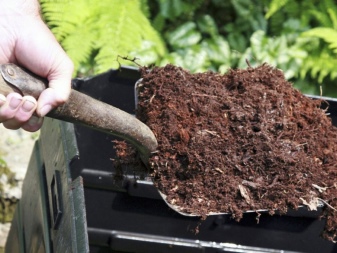
Seeds are planted in the prepared area in spring, in May or in April, but not earlier than the soil warms up to +15 degrees, and the air - to +20. The seeds are buried 15 mm. To increase germination, it is recommended to pre-soak in a weakly concentrated aqueous solution of copper sulfate or an amber solution.
A distance of at least 30 cm is maintained between the individual seed strips.
Before planting, grooves are laid in the ground. The seeds are mixed with agrovermiculite, placed in the soil, then the crops are sprayed from a spray bottle. It will take about 3 weeks to wait for germination. Self-seeding of carnations is possible in regions where there is a moderately cold climate in winter. In severe frosts, seed material will simply not rise in the spring.



It is very important to protect the seedlings of Chinese carnation from negative atmospheric influences. She needs a shelter in the form of a mini-greenhouse, film, covering material. The cover is removed only after the seedlings sprout. Next, it is necessary to thin out the plantings, saving them from unnecessarily weak sprouts, the rejected material can be continued to grow in a pot or container. With the appearance of the second leaf, the distance between the plants should be at least 10 cm. After the 5th shoot emerges, a second pick is made, which allows leaving at least 25–30 cm between the plants.

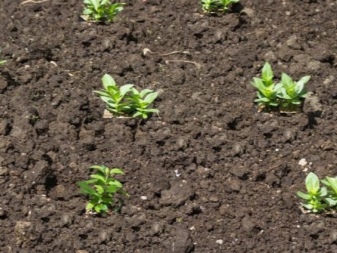
How to take care of it properly?
Carnation of the Chinese carnation is carried out taking into account the characteristics of the plant itself. Pinching the top helps to stimulate the growth and abundant branching of the bush. After flowering, all dried stems and buds must be cut off. This work is done with a pruner, with a deviation from the base of the stem about 15 cm. Some time later, the bush will sprout again.
It is imperative to adjust the watering. Normally, it is carried out weekly, in the heat, increasing the frequency up to 2-3 times a week. In case of heavy precipitation, it is not recommended to add moisture.The watering process is carried out exclusively at the root, it is impossible for it to fall on the leaves or buds, which can provoke diseases.

Proper care also affects the flowering intensity. Chinese carnation needs constant maintenance of the required moisture level. Mulching the root area of the plant will help keep the soil fairly moist. Weeding the weeds on a regular basis will also be helpful.
Carnation of the Chinese carnation is also regularly required. The plant needs sufficient amounts of potash fertilizers, complexes of mineral supplements. In addition, it will be beneficial to introduce a substrate that improves root nutrition. It is necessary to fertilize the cloves once every 2-3 weeks.
During the budding period, it is necessary to add mineral complex fertilizing to the soil.

Wintering of Chinese carnation is normal only in warm climates. In front of it, the perennial is cut almost at the root, leaving no more than 10 cm on top of the soil. Next, the remaining pruning with dry foliage is mulched, the plant is covered with spruce branches... As soon as snow falls, the carnation wintering site is sprinkled with it for additional protection from the cold.
Reproduction methods
Among the most popular breeding methods for Chinese carnation, you can find not only sowing seeds. In regions with more comfortable than temperate climates, it is successfully cultivated as a perennial. Several ways will help to propagate the plant.
- Cuttings. For this procedure, strong, sturdy shoots without buds, with 3-4 knots of leaves are selected. The stalk is cut just below the outermost one. Further, all leaves are removed, except for the topmost ones. Landing is carried out in sand pre-calcined in the oven, under a shelter in the form of a mini-greenhouse. Rooting takes about 21 days.



- Reproduction by layering. This method is suitable for tall, up to 50 cm tall perennials. The lateral shoot of the plant is bent to the ground, placed in a specially dug hole, and fixed with a bracket. Further care for him is carried out as for a separate bush. Rooting lasts about 1 year, then you can cut off the layers of the Chinese carnation from the mother bush and grow it separately.


- Reproduction by dividing the bush. The procedure is relevant for perennials, ensures full inheritance of all characteristics of the parent plant, but is not suitable for all varieties. Division is possible only with a well-developed, overgrown root system. The procedure is carried out in the spring, before flowering. The bush must be completely dug up and cut into the required number of parts. A new seedling should have at least 3 shoots.


- Collecting seeds. For hybrid plants, it is not always relevant, since it excludes the possibility of full inheritance of the qualities of the parent plant. You can collect annual seeds for further planting after they have ripened. Boxes appear in the second decade of August.
The collection is carried out after their color changes to brown.


Diseases and pests
Chinese carnation is practically unaffected by various diseases due to its natural immunity. The source of problems can only be a significant deterioration in growing conditions. For this species, thickening of plantings, increased soil moisture, excess nitrogen levels in the soil, and a lack of potassium are extremely dangerous. In order to prevent fungal infections, it is imperative to exclude planting in the vicinity of a Chinese tulip carnation. In addition, it is recommended to change the place of growth of the flower every 5 years; during long-term cultivation, do not neglect the use of fungicides in the autumn.
Important! When dry areas or rust appears on the leaves of a Chinese clove, the affected plants must be destroyed. The rest of the plantings are treated with fungicides. Spider mites and other pests should be controlled with suitable insecticides.


Use in landscape design
In landscape design, Chinese carnation is used quite widely. Even a flower bed with only these flowers will not look superfluous in the garden space. However, much more often a beautifully blooming, but not having a sharp or bright aroma, a plant adorns alpine hills, serves as part of the borders that beautifully border the paths. Carnations planted around the flower bed look no less impressive and expressive. In pots, flowerpots, containers and hanging pots, Chinese carnations are grown to decorate balconies, terraces, and house facades. It is distinguished by good adaptation to different climatic conditions, and in winter it may well be content with the area of the window sill. Terry varieties and hybrids perfectly set off the territory of the patio or the landscape of the yard.



In the case of Chinese carnation, an island or bouquet planting is used in a lawn frame. A bright mix of flowers or two-tone varieties with an original color of petals will look especially impressive here. The tallest, with stems up to 50 cm, carnations can be used in multi-tiered compositions as background plants. In park compositions, it is often used as the central element of flower beds. Chinese carnation is also planted in large landscape projects as an unpretentious and bright component of the general carpet of plants. When grown for cutting, tall varieties with a large flower cup are used.
The sophistication of bouquet varieties and the variety of their colors allows you to get unique compositions in a vase and on the territory of the garden.


For information on how to grow a Chinese carnation, see the next video.







































































































The comment was sent successfully.